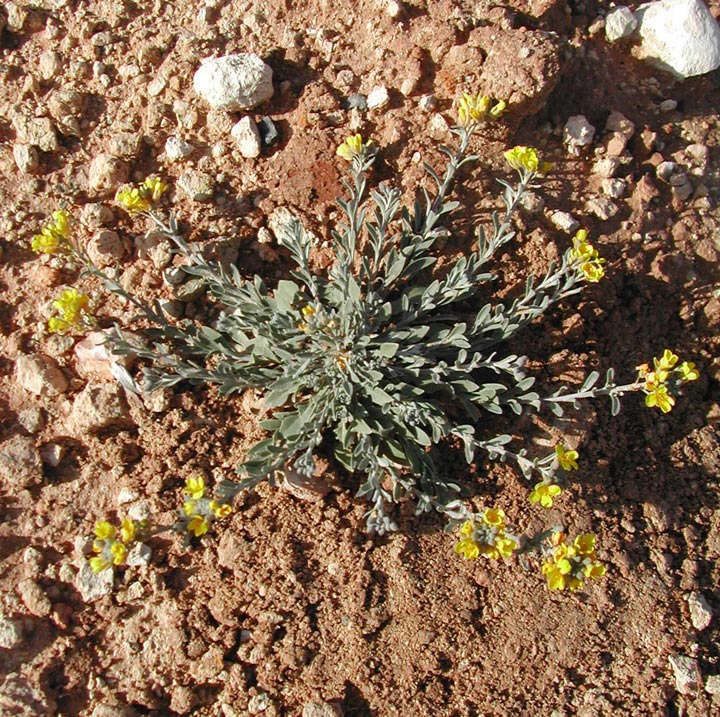|
Family: Brassicaceae |
Annuals, biennials, or perennials; (caudex often present, enlarged, usually branched); not scapose; usually pubescent, trichomes usually sessile, sometimes subsessile or shortly stalked, usually stellate, sometimes stellate-scalelike, rarely simple. Stems erect, spreading, decumbent, or prostrate, unbranched or branched distally. Leaves basal and cauline; petiolate or sessile; basal usually rosulate, petiolate, blade margins usually entire, sometimes repand to pinnatifid; cauline petiolate or sessile, blade margins usually entire, sometimes repand to dentate. Racemes (few- to several-flowered, proximalmost flowers rarely bracteate), elongated or not in fruit. Fruiting pedicels erect, horizontal, divaricate, spreading, ascending, or sigmoid, usually slender, sometimes stout. Flowers: sepals erect or spreading, linear, lanceolate, elliptic, oblong, ovate, or deltate, lateral pair usually saccate basally, sometimes subsaccate or not saccate; petals usually yellow, sometimes orange (occasionally drying purplish or maroon), rarely white or purple, spatulate, obovate, ovate, oblanceolate, or obdeltate, (longer than sepals), claw differentiated or not from blade, (apex usually rounded, rarely slightly emarginate); stamens tetradynamous; filaments usually not dilated basally; anthers ovate to narrowly oblong, (apex usually obtuse); nectar glands confluent, subtending bases of stamens, median glands present or absent. Fruits silicles, sessile, subsessile or, rarely, shortly stipitate, globose, subglobose, orbicular, suborbicular, ellipsoid, elliptic, lanceolate, obcordate, obdeltate, oblong, obpyriform, ovate, ovoid, or obovoid, not torulose, inflated or not, terete, latiseptate, or angustiseptate; valves each often with obscure midvein, (usually not retaining seeds after dehiscence), usually pubescent, sometimes glabrous, or, rarely, pubescent inside; replum rounded to narrowly oblong; septum usually complete, sometimes perforate, or, rarely, reduced to a rim (often with apical midvein extending to center); ovules (2-)4-32(-40[-80]) per ovary; style distinct; stigma entire. Seeds biseriate, often flattened, sometimes plump, rarely lenticular, usually not winged, rarely narrowly winged or margined, often suborbicular; seed coat (smooth), mucilaginous or not when wetted; cotyledons accumbent. x = 4, 5, 6, 7, 8, 9, 10, 12, 15. Seeds of Physaria contain hydroxy fatty acids, and some species, notably P. fendleri, are being intensively studied as a source of specialized, high-quality lubricants. The genus is notable for its relatively large number of local, often endangered, and edaphically-determined (usually calciphilic) endemics. Most of the genus Lesquerella (except for the auriculate-leaved species placed in Paysonia O´Kane & Al-Shehbaz) was recently united with Physaria, which is now much larger but monophyletic and morphologically coherent (I. A. Al-Shehbaz and S. L. O´Kane 2002). Where details of the trichomes are sparse, this is due to an absence of electron microscopy for these taxa (although the number of primary rays and some details are often visible at 10-30× with glancing light). The number of rays of the ubiquitous unicellular, stellate trichomes refers to the primary divisions immediately proximal to the center of the trichome. These primary rays are then typically furcate or bifurcate, often imperfectly so (2 + 1 branches, rather than 2 + 2). Trichome rays are usually appressed or parallel to surfaces on a short stalk; when the rays flare from surfaces, this is noted in the descriptions. Umbonate trichomes have a distinctive raised mound at the center; unless otherwise stated, trichomes are not umbonate. Tubercles are bumps or granules scattered along the rays and often over the center of the trichome. Flowering is likely to occur earlier than indicated in the descriptions, because specimens are typically (and optimally) collected when the fruits are nearly or fully mature, rather than when plants are only in flower. Raceme descriptions refer to mature infructescences unless otherwise noted. In Physaria, didymous is used as a term for fruit shape. A didymous fruit is inflated and appears as two balloons pressed together. The overall fruit shape is otherwise difficult to define and authors have traditionally referred to it this way. Replum shape and placement of the valve orifice are reported for only those taxa that were traditionally placed in Physaria, in the strict sense, where replum shape is sometimes helpful in separating species. The valves of didymous-fruited Physaria typically do not release their seeds; the valves and seeds disperse as a unit; species previously placed in Lesquerella freely release their seeds. The number of ovules reported, easily ascertained by counting funiculi, is most of |


